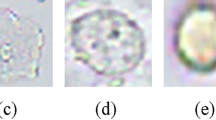Abstract
Urine sediment recognition is attracting growing interest in the field of computer vision. A multi-view urine cell recognition method based on multi-view deep residual learning is proposed to solve some existing problems, such as multi-view cell gray change and cell information loss in the natural state. Firstly, the convolutional network is designed to extract the urine sediment features from different perspectives based on the residual network, and the depth-wise separable convolution is introduced to reduce the network parameters. Secondly, Squeeze-and-Excitation block is embedded to learn feature weights, using feature re-calibration to improve network representation, and the robustness of the network is enhanced by adding spatial pyramid pooling. Finally, for further optimizing the recognition results, the Adam with weight decay optimization method is used to accelerate the convergence of the network model. Experiments on self-built urine microscopic image data-set show that our proposed method has state-of-the-art classification accuracy and reduces network computing time.





Similar content being viewed by others
Change history
12 March 2020
In the original version of this article, the authors��� units in the affiliation section are, unfortunately, incorrect. Jining No.1 people���s hospital and Affiliated Hospital of Jining Medical University are two independent units and should not have been combined into one affiliation.
References
Zhou, X., Xiao, X., Ma, C., A study of automatic recognition and counting system of urine-sediment visual components. International Conference on Biomedical Engineering & Informatics. IEEE, 2010. 256–268.
Li, C. Y., Fang, B., Wang, Y., et al. Automatic Detecting And Recognition Of Casts In Urine Sediment Images. International Conference on Wavelet Analysis & Pattern Recognition. IEEE, 2009:036–045.
Mei-Li, S., Rui, Z., Urine Sediment Recognition Method Based on SVM and AdaBoost. International Conference on Computational Intelligence & Software Engineering. IEEE, 2009:1286–1296.
Fu, C., Xia, S. R., and Zhang, Z. C., [The study of SVM-based recognition of particles in urine sediment]. Chinese Journal of. Medical Instrumentation 32(6):409–412, 2008.
Zaman, Z., Fogazzi, G. B., Garigali, G. et al., Urine sediment analysis: Analytical and diagnostic performance of sediMAX? — A new automated microscopy image-based urine sediment analyser. Clin. Chim. Acta 411(3–4):140–154, 2010.
Luo, H., Ma, S., Wu, D. et al., Mumford-Shah Segmentation for Microscopic Image of the Urinary Sediment. 2007 1st International Conference on Bioinformatics and Biomedical Engineering. IEEE:112–118, 2007.
Canlong, Z., Yanping, T., Qiang, W. et al., A more effective algorithm of automatic recognition urinary sediment. Computer Engineering & Applications 46(3):232–235, 2010.
Yong, Y., and Ping, L., Segmentation of urine sediment image based on improved Canny operator. Computer Engineering and Applications 25(8):253–266, 2010.
Zhou, Y., and Zhou, H., Automatic Classification and Recognition of Particles in Urinary Sediment Images. Lecture Notes in Electrical Engineering 107(226):1071–1078, 2012.
Shen, M. L., and Chen, D. R., Study on urinary sediments classification and identification techniques. Proceedings of SPIE - The International Society for Optical Engineering 2006:25–30.
Yixiong, L., Zhihong, T., Meng, Y. et al., Object detection based on deep learning for urine sediment examination. Biocybernetics and Biomedical Engineering 38(3):661–670, 2018.
Yu, H., Jing, W., Iriya, R. et al., Phenotypic antimicrobial susceptibility testing with deep learning video microscopy. Anal. Chem. 12(7):1128, 2018.
Valenzuela, R., Morningstar, W. A., and Makker, S. P., The renal pathology of chediak-higashi disease: Usefulness of the urinary sediment as a confirmatory diagnostic test. Hum. Pathol. 8(2):230–232, 1977.
Yixiong, L., Rui, K., Chunyan, L. et al., An End-to-End System for Automatic Urinary Particle Recognition with Convolutional Neural Network. J. Med. Syst. 42(9):165, 2018.
Kang, R., Liang, Y., Lian, C. et al., CNN-Based Automatic Urinary Particles Recognition. 34(32):129–141, 2018.
Hans, C., Merchant, F. A., Shah S, K., Decision fusion for urine particle classification in multispectral images. the Seventh Indian Conference on Computer Vision, Graphics and Image Processing, 2010. 419–426.
Brock, D. A., and Hundley, J. M., Identifying Calcium Oxalate Crystals in Urine. Lab. Med. 26(11):733–735, 1995.
Delanghe, J., New screening diagnostic techniques in urinalysis. Acta Clin. Belg. 62(3):155–161, 2007.
Targ, S., Almeida, D., Lyman, K., Resnet in Resnet: generalizing residual architectures. arXiv preprint arXiv:1603.08029, 2016.
Sünderhauf N, Shirazi S, Dayoub F, et al. On the performance of convention features for place recognition. Intelligent Robots and Systems (IROS), 2015 IEEE/RSJ International Conference on. IEEE, 2015: 4297–4304.
Redmon, J., Divvala, S., Girshick, R. et al., You only look once: Unified, real-time object detection. Proc. IEEE Conf. Comput. Vis. Pattern Recognit.:779–788, 2016.
Ren, S., He, K., Girshick, R. et al., Faster r-cnn: Towards real-time object detection with region proposal networks. Adv. Neural Inf. Proces. Syst.:91–99, 2015.
Acknowledgements
The fund is from the Affiliated Hospital of Jining Medical University, Clinical significance of urine protein detection in pregnant women during different pregnancy and correlatin with Physiological indicators during pregnancy (No. MP-2016-011).
Author information
Authors and Affiliations
Corresponding author
Ethics declarations
Conflict of interest
We declare that we have no conflict of interest.
Human and animal rights
The paper does not contain any studies with human participants or animals performed by any of the authors.
Informed consent
Informed consent was obtained from all individual participants included in the paper.
Additional information
Publisher’s Note
Springer Nature remains neutral with regard to jurisdictional claims in published maps and institutional affiliations.
This article is part of the Topical Collection on Image & Signal Processing
Rights and permissions
About this article
Cite this article
Zhang, X., Jiang, L., Yang, D. et al. Urine Sediment Recognition Method Based on Multi-View Deep Residual Learning in Microscopic Image. J Med Syst 43, 325 (2019). https://doi.org/10.1007/s10916-019-1457-4
Received:
Accepted:
Published:
DOI: https://doi.org/10.1007/s10916-019-1457-4




